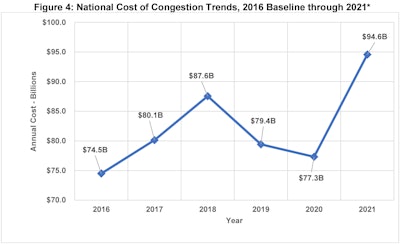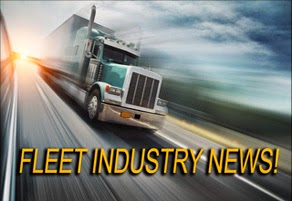Trucking news and briefs for Thursday, Oct. 26, 2023:
Congestion worth an annual $94.6 billion in costs, hitting a record
Traffic congestion on U.S. highways added $94.6 billion in costs to the trucking industry in 2021, according to the latest Cost of Congestion study published by the American Transportation Research Institute (ATRI). The cost of congestion in 2021 is the highest level yet recorded through ATRI’s ongoing research initiative.
ATRI utilized a variety of data sources including its unique truck GPS database to calculate trucking delay impacts from 2017 through 2021 on major U.S. roadways. While year-over-year congestion costs decreased in 2020 due to the COVID-19 pandemic, they rose sharply in 2021 with a total of 1.27 billion hours of lost productivity.
ATRI said the increase in costs reflected the dramatic post-COVID economic recovery, with high GDP growth and freight demand from record levels of consumer spending in 2021.
 Prior to 2021, the highest congestion cost was seen in 2018, when delays cost the trucking industry $87.6 billion. Due to the economic downturn in 2019, congestion costs dropped to $79.4 billion, and then further receded in 2020 to $77.3 billion due to reduced congestion during the COVID-19 pandemic.ATRI
Prior to 2021, the highest congestion cost was seen in 2018, when delays cost the trucking industry $87.6 billion. Due to the economic downturn in 2019, congestion costs dropped to $79.4 billion, and then further receded in 2020 to $77.3 billion due to reduced congestion during the COVID-19 pandemic.ATRI
The delays due to congestion equate to more than 460,000 commercial truck drivers sitting idle for one work year, and the 2021 figure represents a 27% increase from the report’s baseline year of 2016 -- an increase that is twice the rate of inflation.
In addition to the national findings, ATRI’s analysis also documented state and metropolitan delays and related cost impacts. The top 10 states each experienced costs of more than $3 billion, led by California ($9 billion), Texas ($7.26 billion) and Florida ($7.16 billion). Combined, the top 10 states ultimately account for more than half (53%) of trucking’s congestion costs nationwide.
Since ATRI began tracking congestion costs in 2016, Nevada has seen the highest percentage increase over time, rising 117.2% from $293.02 billion to $636.38 billion.
Additionally, the New York City metropolitan area ranked highest for cities, with costs approaching $5.5 billion annually.
The report also documented transportation investment by states through the Infrastructure Investment and Jobs Act (IIJA), which could provide as much as $350 billion in funding to address congestion.
ATRI’s analysis also found that truckers wasted more than 6.7 billion gallons of diesel fuel in 2021 due to congestion, resulting in more than $22.3 billion in additional fuel costs.
[Related: Texas again home to the worst traffic in the U.S.]
UMass research team exploring effect of automation on truck drivers
A team of University of Massachusetts Amherst researchers has received a grant to explore how automation will affect the role of American long-haul truckers.
An interdisciplinary group of researchers led by Shannon Roberts, associate professor of mechanical and industrial engineering, has been awarded nearly $2 million over four years by the National Science Foundation’s (NSF) Future of Work Program.
“We know that when automation is introduced into trucks it changes the role of a trucker,” Roberts said. “The question we are asking is: how do we examine and improve upon the future of work in long-haul trucking not by focusing on technology development, but rather by focusing on the trucker?”
Co-principal investigator Laurel Smith-Doerr, sociology, said she appreciates the leadership of Roberts in developing this project's unique contribution.
“Unlike other research projects on the future of work in long-haul trucking that assume driverless automation, our interdisciplinary, NSF-funded project centers the driver in the process of imagining the future of work in trucking,” she said.
Some of the methods the team plans to use to collect the information include ridealongs and participatory design with haulers and workforce development analysis. “We’re working with this workforce. That is, truckers,” Roberts said. “One of the things that will make this project successful is our stakeholders.”
Roberts said the role that technology plays and the needs of truckers have to be carefully balanced. “Let’s focus on taking the best of both worlds to make sure they work together seamlessly. In the end, that will reap the greatest benefit.”
[Related: FMCSA to study driver interactions with autonomous tech]
Automation theoretically could lead to benefits in fewer crashes and better efficiency, proponents believe, yet that doesn’t mean the human should be removed from the equation entirely, the researchers said.
“Technology is good at handling consistent situations with predictable, rational people,” Roberts noted. No all situations or people are predictable, though. “Technology will not be able to react to everything that might happen on the road. It’s impossible. We will need a person in the truck.”
At the same time, automation shouldn't be allowed to make workers feel expendable.
“People take pride in what they do,” she added. “We don’t want to take everything out of that job such that people are unsatisfied and unhappy. Many people get into trucking as a means to move into the middle-class lifestyle with a high school diploma or a GED. It’s a means of betterment for a large chunk of the population.”
Ultimately, Roberts said her questions lead to a topic she calls the human-truck symbiosis.
“How do we take advantage of all the things that people are good at doing, and all the things that technology is good at doing to make sure we have a system that works really well?” Roberts asked.
Others on the research team include Henry Renski, regional planning; Shlomo Zilberstein, computer science; Michael Knodler, civil engineering; and Robin Riessman, UMass Transportation Center, as senior personnel.
[Related: Will autonomous trucks displace drivers? Congress holds hearing on impacts]
Speed limit increased on I-17 near Phoenix
Following an independent study and public input, the Arizona Department of Transportation is raising the Interstate 17 speed limit south of Peoria Avenue to 65 mph.
The new speed limit will take effect when ADOT replaces the current 55 mph signs along I-17 between the I-10 “Split” interchange and Peoria Avenue in Phoenix, which is expected to be done by the end of October.
The study determined a 65-mph speed limit within that stretch of I-17 is appropriate since it more closely reflects the speed most people are currently driving and find reasonable. This is likely to improve compliance, providing an effective tool for law enforcement.
The evaluation also notes a 65-mph speed limit can result in more drivers traveling closer to the same speed, which enhances safety.
The speed limit is at least 65 mph on all other stretches of interstate highways in the Phoenix area.
Nearly 11,000 people submitted feedback to ADOT in a public survey. Approximately 75% of respondents supported raising the speed limit to 65 mph.
[Related: Speed limiter mandate: Owner-operators call out FMCSA's misplaced priorities]
from Overdrive https://ift.tt/1egYIqy



Sourced by Quik DMV - CADMV fleet registration services. Renew your registration online in only 10 minutes. No DMV visits, no lines, no phone mazes, and no appointments needed. Visit Quik, Click, Pay & Print your registration from home or any local print shop.





0 comments:
Post a Comment